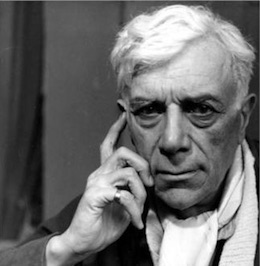Georges Braque
1882 (Argenteuil) / 1963 (Paris)
Even before his meeting with Picasso, when Braque abruptly adopted Fauvism between 1906 and 1907, at the instigation of the Le Havre artist Othon Friesz, it was because, he said, "not liking Romanticism, this physical painting appealed to me". Physical: that says it all. Far from being the slow, serious, thoughtful - not to say laborious and boring - character of the legend, in contrast to the quick-witted, inventive and mischievous Picasso, Georges Braque was, on the contrary, instinctive, stubborn and nervous. In contrast to Picasso's Latin verbal facundity, he has simply kept the attitude of a "silent man" from his childhood in the Cauchoise region, limiting his thoughts to a few aphorisms (which he was wrong to publish, as these few sentences on "the rule that corrects emotion" earned him the wrath of Breton). A born fighter, Braque - for whom "a painting is finished when the idea has disappeared" - prepared the shots he had in mind, producing five paintings when Picasso, always in a hurry, dropped thirty. When talent is called upon," summed up the Norman, "it is because imagination is lacking. The builder - the boss, said Paulhan - is Braque.
Even before his meeting with Picasso, when Braque abruptly adopted Fauvism between 1906 and 1907, at the instigation of the Le Havre artist Othon Friesz, it was because, he said, "not liking Romanticism, this physical painting appealed to me". Physical: that says it all. Far from being the slow, serious, thoughtful - not to say laborious and boring - character of the legend, in contrast to the quick-witted, inventive and mischievous Picasso, Georges Braque was, on the contrary, instinctive, stubborn and nervous. In contrast to Picasso's Latin verbal facundity, he has simply kept the attitude of a "silent man" from his childhood in the Cauchoise region, limiting his thoughts to a few aphorisms (which he was wrong to publish, as these few sentences on "the rule that corrects emotion" earned him the wrath of Breton). A born fighter, Braque - for whom "a painting is finished when the idea has disappeared" - prepared the shots he had in mind, producing five paintings when Picasso, always in a hurry, dropped thirty. When talent is called upon," summed up the Norman, "it is because imagination is lacking. The builder - the boss, said Paulhan - is Braque.
Artist's exhibitions
Georges Braque, Jacques Bosser. Pour un art poétique
16/06/2023 - 02/09/2023
(Colmar) Galerie Murmure
16/06/2023 - 02/09/2023
(Colmar) Galerie Murmure
De Matisse à Chagall, l’aventure des peintres témoins de leur temps
26/05/2023 - 28/01/2024
(Lyon) Musée Jean Couty
26/05/2023 - 28/01/2024
(Lyon) Musée Jean Couty
Inspiration Matisse
27/09/2019 - 19/01/2020
(Mannheim) Kunsthalle Mannheim
27/09/2019 - 19/01/2020
(Mannheim) Kunsthalle Mannheim
Même pas peur ! Collection de la baronne Henri de Rothschild. Vanités d’hier et d’aujourd’hui
29/06/2018 - 30/09/2018
(Toulouse) Fondation Bemberg
29/06/2018 - 30/09/2018
(Toulouse) Fondation Bemberg
Vivantes natures
22/05/2017 - 05/11/2017
(Biron) Château de Biron
22/05/2017 - 05/11/2017
(Biron) Château de Biron
Chefs-d'oeuvre de la collection BĂĽrhle
07/04/2017 - 29/10/2017
(Lausanne 8Â Bellevaux) Fondation de l'Hermitage
07/04/2017 - 29/10/2017
(Lausanne 8Â Bellevaux) Fondation de l'Hermitage
Picasso.mania
07/10/2015 - 29/02/2016
(Paris) Grand Palais
07/10/2015 - 29/02/2016
(Paris) Grand Palais
Leiris & Co. Picasso, Masson, Miró, Giacometti, Lam, Bacon…
03/04/2015 - 14/09/2015
(Metz) Centre Pompidou-Metz
03/04/2015 - 14/09/2015
(Metz) Centre Pompidou-Metz
Georges Braque
18/09/2013 - 06/01/2014
(Paris) Grand Palais
18/09/2013 - 06/01/2014
(Paris) Grand Palais
Passion de Collections, Collection de Passion
07/11/2009 - 17/01/2010
(Tours) Château de Tours
07/11/2009 - 17/01/2010
(Tours) Château de Tours
De Corot à l’art moderne, souvenirs et variations
20/02/2009 - 24/05/2009
(Reims) Musée des Beaux-Arts de Reims
20/02/2009 - 24/05/2009
(Reims) Musée des Beaux-Arts de Reims
artist_books
Georges Braque et le paysage De l’Estaque à Varengeville 1906-1963
Ouvrage collectif Éditions Hazan/Musée Cantini A priori, le sujet majeur de l’oeuvre de Braque n’est pas le paysage. Ce “père de la modernité” est plus connu pour sa participation à la révolution que fut le cubisme. Néanmoins, à y regarder de plus près, le paysage est un élément qui perdure dans son oeuvre et qui se révèle être un fabuleux terrain de recherches et d’à ...
